Welcome to the Team Foundation Server 2012 Starter. This book has been especially created to provide you with all the information that you need to speed with Team Foundation Server 2012 (TFS 2012). You will learn how to set up TFS 2012, get started with version control, work items, continuous build and manual functional testing, and learn some best practices and useful tricks of the trade. You will also learn to access the TFS from other tools including Excel, and utilize the Web Access for those roles who don't use Visual Studio as their daily tool.
This document contains the following sections:
So what is TFS 2012? – find out what TFS 2012 actually is, what you can do with it, see common scenarios for use, and why it's so great.
Installing TFS 2012 – this section shows the different upfront choices regarding the adaption of TFS 2012 to your organization that you have to make, how to install it in different setups, and how to configure it for maximum benefits
The section covers:
Local install
On-premises single server setup
TFS Services (Azure) setup
Quick start – after installing TFS 2012, learn how to quickly get started with your first project. This section covers:
Creating a new Team Project with the appropriate process template
Creating a product backlog and planning a sprint
Adding a solution to source control
Creating a Continuous Integration build
Top features you need to know about – TFS 2012 is more of a platform than a fixed product. It can be configured, adapted, and extended to match your needs to a very high degree. This section will cover the use of the fundamental features of TFS 2012, which do not require any adaption. You will learn about the following:
Version control – the following topics will be covered here:
The fundamentals of TFS 2012 version control, using changesets, checkins, and history
Retrieving code from any version, annotation, labels, and so on.
How to structure your source code according to best practices and plan for future branching
How to branch and merge your code
Migration from Visual Source Safe
Work items – the following topics will be covered here:
The fundamental work items types and how to use them
Creating work items
Querying work items
Transferring work items to other tools, such as Excel
The Agile workbench – the following topics will be covered here:
How to use the new Agile Workbench
Setting up teams and areas
Planning iterations
Using the backlog
Using the task board
Build – the following topics will be covered here:
You can't live without the TFS Build! Here you learn how to use it!
Setting up a minimum build system
Configuring a Continuous Integration build for your solution
Monitoring builds
Functional test – the following topics will be covered here:
How to do functional testing—manually or automated
Setting up a test plan
Performing a test run
Doing exploratory testing
People and places you should get to know – in this day and age, it is impossible to live without the Internet and it is here that you can find resources as well as help for your possible TFS 2012 woes. This section provides you with many useful links to the project pages and forums, as well as a number of helpful articles, tutorials, blogs, and the Twitter feeds of TFS 2012 super-contributors.
Team Foundation Server 2012 (TFS 2012) is the latest version of Microsoft's Application Lifecycle Management (ALM) system. It covers all the aspects of managing a software product over its complete lifecycle, from inception, through development and the subsequent maintenance phase for as long as it is in use.
TFS 2012 governs all the aspects of software development, including requirement management, project management, development, testing, deployment and quality assurance. It has four major traits that make this very valuable:
Traceability
Visibility
Automation
Flexibility
An important aspect is the multiple ways of accessing TFS 2012. It can be accessed using the brilliantly new Agile Web Access, using Visual Studio, or a multitude of other development IDEs, Microsoft Office products, or even through Java development platforms such as Eclipse. There is also a rich ecosystem of third-party tools available, which integrates into TFS 2012. Some examples include inteGREAT from eDevTech, TeamCompanion from Ekobit, and InRelease from InCycle Software.
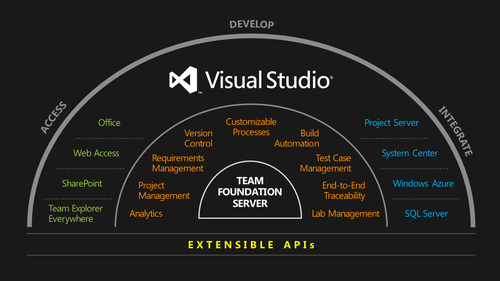
TFS 2012 has four major operational parts or stores, namely the work item system, the version control system, the build system, and the test system. In addition, it has a reporting data warehouse and a SharePoint project portal; the latter can be used for both document management and for accessing reports. It is a multi-role system, so that all the major roles in an organization can use TFS 2012 for their own purpose.
TFS 2012's major advantage lies in its internal integration. All the stores are coupled together so that information is automatically linked together as the different operations take place.
A typical case story for how different roles work together using TFS 2012 is as follows:
A Stakeholder adds a requirement to the work item system using the Agile Web Access.
An Architect sits down with the stakeholder and enters test cases as the acceptance criteria into the work item system using the test manager, and in doing so, connects the requirements with the test cases.
The Product Owner moves the requirements into the upcoming sprint.
The Scrum Master sits down with the team and breaks down the requirement in tasks using Excel.
The Developer receives the task in Visual Studio and develops the source code. He/she checks in the source code to the version control system of TFS 2012, and in doing so connects the task work item with that source code.
The TFS 2012 build system detects the check in and starts an automated build. The build is connected to both the source code and the task work item.
The tester detects a new build in his test manager, and starts running a new test run based on the test cases entered earlier and the compiled code based on the new build.
A Bug is detected, and the Test Runner collects information from the Test System with all its Test Results, connects this to the bug, and the bug to the test case and the build.
The circle is now complete—all these artifacts are all stored in TFS 2012 and what is so great—the artifacts are all linked together! Anyone can now access this information from any point, and drill down into any other part of connected items.
This story showed a scenario with many roles and many processes in place, but you can start much simpler. You can even start without nearly anything. For example just start with testing, run an exploratory test session with nothing else in place; just run the test and create bugs as you find them. From there you can, if you like, use the bugs to create test cases, and collect the test cases together to form user stories.
These are just some examples of the flexibility you have. TFS 2012 can support nearly any process you have, and you can choose for yourself how much or how little you want to use. Then, as time goes on, you can add more features, without compromising anything you have done earlier.
TFS 2012 can be installed in multiple ways. We will cover the most common ones, which are as follows:
Basic installation: This is an install on any local computer you have, and installs on Windows 7, Windows 8, or any of the server operating systems from Windows Server 2008 and upwards. It's a great way to try out TFS, but can be used in production for single developers or small teams, and is covered under the TFS Express license.
The Basic installation gives you Source Control, Work Items, Build automation, and Test Management. There is no Data warehouse, reports, or SharePoint portals included.
Standard/advanced installation: The solution for larger companies is the server installs or Advanced configurations. There are multiple ways to configure this, and we will cover a fundamental single server install with the build server separately.
Team Foundation Service: This is the hosted version of TFS. You only need to sign up to the service. The offering is currently free, but Microsoft will charge for this service at some time in the future.
Basic installation is well suited when you want to try out the core functionality of TFS. You can install and configure TFS Basic on your local machine in less than ten minutes.
Start by running the installation (Setup.exe) from the TFS installation media. The installation itself just installs all the binaries; it doesn't require you to configure anything. It will install the .NET 4.5 Framework, which might require a machine restart as part of the installation.
The interesting things happen afterwards when you run the Configuration Center. This wizard launches automatically and lets you choose what kind of installation of TFS 2012 you want.
In the Configuration Center window, select the Basic option and press the Start Wizard button. On the Welcome page that follows, press Next.
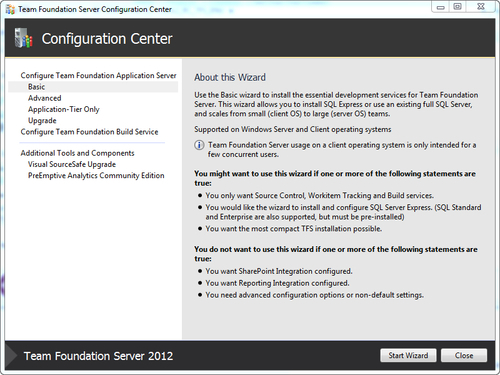
Now, you need to choose which database server you want to use. You have the following two options:
Let TFS install SQL 2012 Express for you
Point to an existing SQL Server instance, which must be SQL 2008 R2 or SQL Server 2012
If you already have an existing SQL Express instance on your machine, then the first option is disabled, as shown in the following screenshot:
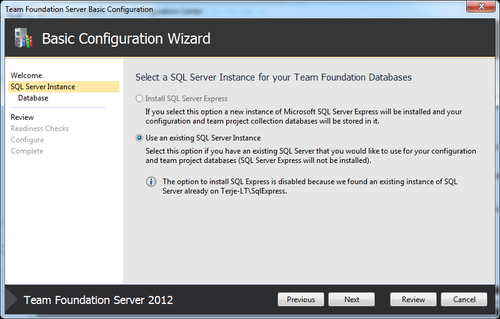
If you do point to an existing SQL instance, then you need to supply a name for SQL Server Instance. Note that the SQL server must be located on the same machine; the Basic installation does not support remote SQL servers.
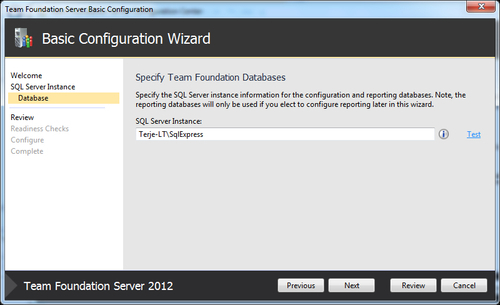
Also note that if the existing SQL instance Express is not a SQL 2012 Express instance, then it will be automatically upgraded to SQL 2012 Express. However, if your installation is not at least SQL 2008 SP2 Express, then you will be asked to upgrade to that level first.
The next page will run through a set of review steps, making sure that everything is configured correctly. If any errors are shown here, you need to correct them and then you can re-run the reviews. Press Next to start the configuration.
Now, the configuration wizard will perform the configuration to complete the installation of TFS 2012:
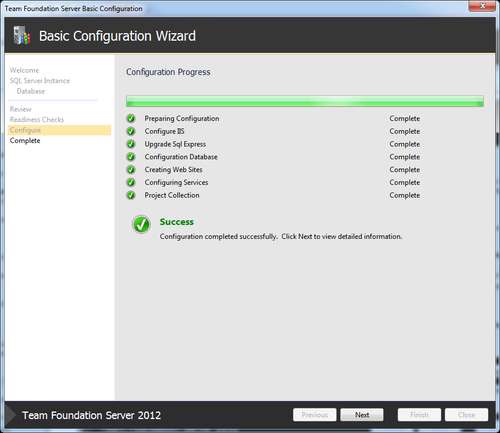
The installation is now complete. The information shown on the final screen includes the URL, which all users will use for connection, and some information about what changes were made by the configuration wizard on external resources, such as IIS and the Firewall:
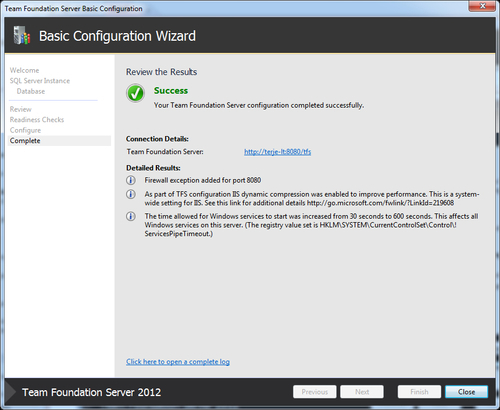
You are now ready to start using TFS 2012! Check out the Quick Start section for how to quickly get started on a new project.
For the production server, a full TFS server install should be used. This includes, in addition to the core TFS components, SQL Reporting Services for the reports, SQL Analysis Services for the data warehouse, and Windows SharePoint Foundation for the team project portals. When using the Standard installation option, everything will be installed on the same machine. If you need to scale out your TFS installation from the beginning (for example, by using a separate server for the data tier) then you must choose the Advanced installation option. Note that you can always scale out your deployment later.
The Standard installation and configuration has three main differences compared to the Basic installation:
You need to supply a Windows account that is used as the service account for SharePoint Products and for the read-only account, for accessing the SQL Server Reporting Services reports. It does not need to have any special permission; a normal workgroup/domain user is enough:
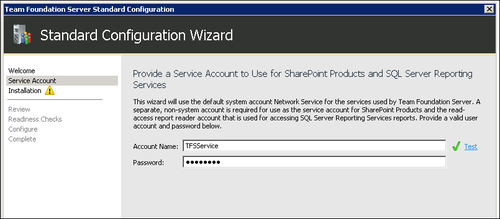
SQL Server will not be installed; there must be a SQL Server running on the machine before you configure the TFS installation. Note that the SQL Server must have been installed with both SQL Reporting Services and SQL Analysis Services.
The Standard installation option will install Microsoft SharePoint Foundation 2010 as part of the installation process, unless already installed:

Another great option, not only for quickly trying out TFS but also for use in production, is the hosted version of TFS. This is TFS running in Windows Azure. Team Foundation Service fully supports Source Control, Work Items, Test Management, and Build Automation. It does not (currently) include support for data warehouse, reports, and a SharePoint portal.
All you need to sign up to TFS Service is a Live ID account. If you don't have one, sign up at https://signup.live.com.
Go to http://tfs.visualstudio.com, and click on the get started for free link:
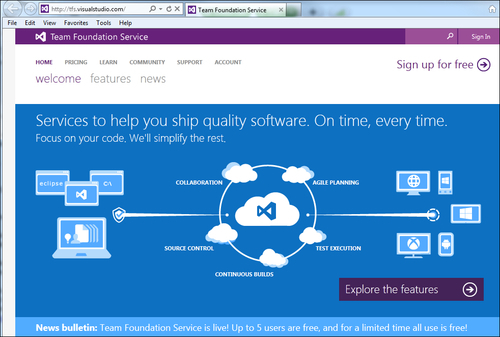
Create your TFS account using your Live ID:

There is currently only the Windows Live ID identity provider that works for TFS Service, so leave this screen as it is.
In this chapter, we will walk through a sample project and, using that as an example, work through the different steps that you need to do to get this into the TFS 2012, including setting up the team project, adding requirements, using the source control, and setting up a build.
We will use the fictional Packt Diner restaurant as the sample project. The restaurant needs an application for its waiters, to help them automate the order processing and payment. This application will be called WaiterApp. We will have two developers on the team, Jakob and Terje, and a project owner, Meeta.
We will connect from our client machine to a TFS 2012 server using Visual Studio or the Web Access.
When you installed TFS2012, you were given a URL to the instance.If you don't remember it, open up Team Foundation Server Administration Console, found under All Programs/Microsoft Visual Studio Team Foundation Server 2012 on the machine where you installed the server:
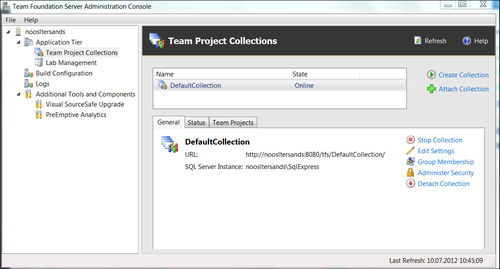
Select the Team Project Collections under Application Tier, and notice the URL for DefaultCollection. It will look similar to the previous screenshot, except that the first name will be the name of your computer (name of the computer on which you installed TFS 2012 on).
Back in Visual Studio, locate the Team menu, and select Connect to Team Foundation Server.
The Select the Team Foundation Server list will be empty, so press the Add Servers button.
In the Add/Remove Server dialog box, the list will be empty. So press the Add button.
In the Add dialog box, enter the computer name (found in step 2) in the Name or URL of Team Foundation Server field. Leave the other fields as they are by default. Verify that the URL that gets displayed in Preview field must match the one found in step 2. Also notice that you can paste in a complete URL in the first field.

Accept by pressing the OK button. A confirmation dialog will then pop up; accept that. You will now see the connection dialog box. Press the Connect button.
You have now connected Visual Studio to the TFS 2012 instance.
A Team Project is a TFS 2012 organizational term that provides isolation. It can represent many things, but in this case we will let it represent the Packt Diner restaurant. The restaurant may want many applications over time, and all those will be organized under this umbrella. We will also decide that the restaurant will use the Scrum process as its development process.
First, we need to create the team project. For an on-premises installation, you can only do this from the Team Explorer within Visual Studio. For the TFS Service you can also do it from the Welcome page using the Web Access. We will show how to do it from Visual Studio, as follows:
Start Visual Studio.
Open Team Explorer (if you don't see it, go to the View menu and select Team Explorer):

Select Create a New Team Project….

Enter a name for the Team Project. The name can contain spaces, but since the name will also be part of the URL for the Team Project, and any space translates into
20%, it is wise to skip the spaces in the Team Project name.Enter a suitable description and press Next.
You can now select between the available process templates. Accept the default Scrum template and press Next.
You can now select between creating a new empty Source Control folder, or branch from an existing one. We want the former, the default, so just press Next here too.
Select Finish on the last page, and the Team Project creation process will start. It usually takes around one or two minutes to create a team project.
We will now create the next level, which is the Team. In this case, we will equate a Team with an Application, since we will use the actual team (Terje, Jakob, and Meeta) for all the applications, but they will be managed separately.
Go to the Team's Web Access site, using the Web Access node of Visual Studio Team Explorer (from the Home tab):
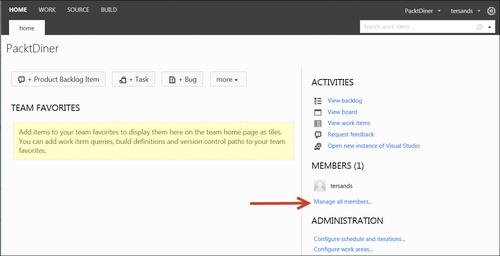
Select Manage all members.
Add the other Team members using the Add button.
Areas are used for categorization of work, and we will assign one area to the top level, which will match the application we are to make, and two sub-areas that will match the two functional levels Meeta wants us to develop, Ordering and Payment. She wants two releases of the product, and we plan to do these with two iterations/sprints each. Release planning is done using the Iteration feature.
Go to the Team's Web Access site, using the Web Access node of Visual Studio Team Explorer (from the Home tab):
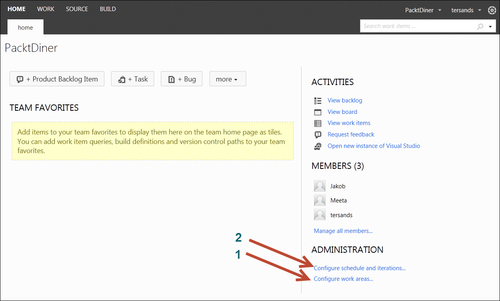
Select 1 (as marked in the preceding screenshot) for configuring the work areas.
Add a child named
WaiterApp, which will be the name of our Application. Below this, add two child areas for Ordering and Payment; these are the two functional areas that we will develop.Remove the checkbox in front of PacktDiner (ignore the warning that comes up)
Select the checkbox for the WaiterApp. Note that default area is also moved down to this area. It should now look similar to the following screenshot:

The areas are now set up as they need to be, and WaiterApp is associated with your team.
Now we will set up the release plan. Close the Areas dialog box, and click on Configure schedule and iterations (highlighted as 2 in the screenshot after step 1). You will see a default setup with releases and sprints.
We will prepare the plan for multiple applications, so add a new child below the root node, and name it
WaiterApp.Consider your company release strategy
You have the following two choices:
Make all the developments follow the same schedule: In this case, use the Microsoft default. There is no requirement to include the application names below the
rootfolder.Let every development have its own schedule: In this case, follow our example and add the application names below the
rootfolder.
Drag the Release 1 and Release 2 nodes under
WaiterApp.Decide upon the cadence for your sprints, and add dates to the two sprints in each release following that cadence. It is quite common to set sprint cadence to two or three weeks. You don't need to add dates to the release nodes.
Dates are added to the sprint by selecting the sprint. A clickable Set Dates link appears, and from that you can set the start and end date of the sprint.
Delete the remaining sprints and releases by right-clicking on the nodes, and select Delete. You will be asked where to place any work items with that iteration path; just accept the default, since there are no work items yet.
Move the checked box to the WaiterApp iteration node.
Select the WaiterApp node, right-click and select Set as team's backlog iteration.
Select the checkboxes in front of the sprints.
Rename the four remaining sprints as shown in the following screenshot. Select each of them, right-click and open them to edit the names. We add a prefix to the sprint numbers to indicate the release numbers.
It should now look similar to the following screenshot:
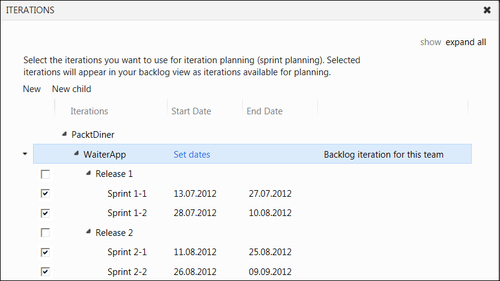
The functional categorization and release plan are now set up, and the team is associated with this project. All Product Backlog Items (PBIs) you want to include in the project should start out by having their iteration path set to WaiterApp, the backlog for this application.
Meeta wants us to focus on two PBIs, namely Place Order and Calculate Bill. This will allow the waiter to take an order, using the Place Order user story, and to calculate the bill afterwards, using the Calculate Bill user story.
Go to the Team's Web Access site, using the Web Access node of Visual Studio Team Explorer (from the Home tab):

You can add the PBIs directly from this page by clicking on Product Backlog Item (marked as 1 in the preceding screenshot), which brings up a detailed work item form, or you can go to the Backlog view by clicking View Backlog (marked as 2 in the preceding screenshot), and add the items from there using a quick add function. For now, click on 1, as we will add some more details than the quick add function allows.
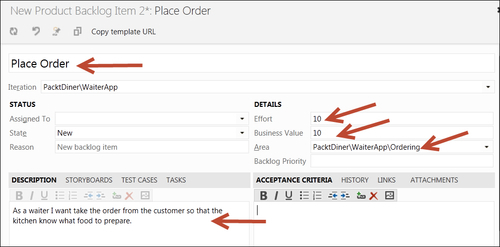
Change the information in the form as indicated in the preceding screenshot (indicated using the arrows).
Add another PBI named Calculate Bill, use the same values, but make the Area point to the Payment sub-area.
We should now choose the first PBI for development in the first sprint. This is done in the Product Backlog view.
Select View Backlog.
Drag the Place Order user story over the Sprint 1-1 node (arrow 1):

Each PBI should be split into tasks. The developer will work with tasks, and the sprint planning will be done by using tasks.
Select Sprint 1-1, (arrow 2 in preceding screenshot), to see the Sprint 1-1 backlog.
The Place Order user story will be shown in the list.
Press the + sign to add a task to the PBI, and set the title to Implement UI.

Add the 10 remaining hours, and set Activity to Development. Click on Save and Close.
Add two more tasks, Implement Business Logic and Implement Storage Service, in the same way.
Add a task named Add test cases, but set Activity to Requirements.
The Sprint Backlog view should now look similar to the following screenshot:

Add child work items "in context" of the PBI.
Note that the tasks we add here "inherit" some information, such as area and iteration paths, from their "parent". This is because we add the tasks "in context" of the parent PBI. Make a habit of always adding child tasks, test cases and bugs "in context" of the parent. You do that either from this backlog view or by opening the PBI and adding the items using the New button under one of the tabs—Implementation, Test Cases, or All Links.
To set up the source control structure, you use Visual Studio. We will add a structure that will allow further projects for other applications, and which will also allow for possible branching.
Go back to the Team Explorer node in Visual Studio, choose the Home node if not selected, and select the Source Control Explorer link button, found under the Pending Changes node (arrow 1 in following screenshot), to open up the Source Control Explorer window:

You need to map the source structure to a local disk. Press Not mapped (arrow 2 in preceding screenshot), and select a suitable location in the dialog box that appears (for example,
c:\PacktDiner).Answer No to the question if you want to download all items.
The Create Folder button (arrow 3 in preceding screenshot) is now enabled. Create the folder structure as follows:

Click on the Pending Changes link in the Team Explorer node (arrow 2 in preceding screenshot).
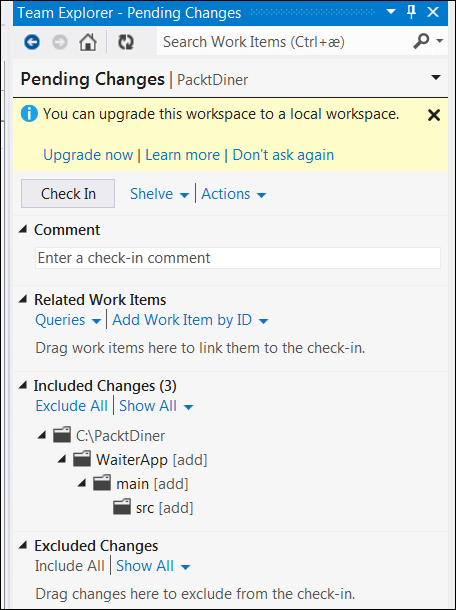
You will now be asked if you want to upgrade the workspace to a local workspace; answer by selecting Upgrade now.
Then enter some data for the Comment text area, such as
Folders added, and click on the Check In button.
We will now add the code for the application to source control. We will use a readymade code snippet for this. In a normal situation, the developer would start out by creating a new solution, place the solution in the src folder, and add that to source control. Keep all code and libraries you need below the solution root folder (src). Avoid spreading them over multiple root folders. This will make the workspace setup much easier as you only need one mapping there, and there is less chance of mixing up the folder structure as it can be from a multiple root solution. If the workspace mapping gets too complex, it can also be hard to make it build correctly on the build server.
To save you the work of writing the code yourself, download the sample code from http://www.packt.com/tfs2012starter/download/waiterapp.zip.
Unzip the code and place it all under the
srcfolder.From the Source Control Explorer window, press the Add files to source control icon:

If you use a local workspace, TFS 2012 will pick up the added files and show them as detected changes in the Pending Changes view.
In the Team Explorer, under the Home tab, press Pending Changes and add a suitable comment, such as Added waiter app solution, and click on Check In.
You should normally install the build system on a separate server. It may very well be a virtual server. If you're just playing around with the system or if there are very few developers, then you may install it to the same machine you have installed the TFS 2012 Server on.
Start the installation from the TFS install media, as mentioned in the Installation section.
When the TFS Configuration wizard appears, go to the Build Configuration tab and select Configure Installed Features.
Start the wizard and press Next.
On the Project Collection page, browse to the DefaultCollection URL (http://TFSServer:8080/tfs).
Add the recommend number of build agents, one per core of your server.
When selecting the build service account, select Use a system account and then choose NT AUTHORITY\NETWORK SERVICE (default).
Run through the rest of the wizard.
You should always create a Continuous Integration (CI) build for your solutions. Make it a habit to have a consistent naming scheme for your builds. We will use the following pattern here: ApplicationName.BuildType, and in this case WaiterApp.CI.
Go to the Team Explorer - Builds window in Visual studio.
Select the Builds tab.

Select New Build Definition, and work through the tabs as follows:
General: Set the name to
WaiterApp.CITrigger: Select Continuous Integration
Workspace: Click into the first row of the source folder column and change the folder here to
$/PacktDiner/WaiterApp/main/srcBuild Defaults: The controller you installed should already be visible and selected; if not, select it
Open Explorer on the build server. Create a folder named
Drops.Change the properties to make this folder a shared folder.
Check the permission to ensure that the account the build service is running under (often the local Network Service account is used) has complete control over this folder.
Add the name of the computer and folder to the Staging location field:

In the Process tab go to Items to build, and select WaiterApp.sln.
Save the build definition.
Right-click on the new build definition, and select Queue a new build.
After a little while, it is shown as a green build, which means that you have succeeded in setting up an integrated TFS 2012 environment.
Now, try to make some small changes in one of the files in the solution/project. Notice that the file is automatically checked out (red check mark). Right-click on the file, choose Check In, and you're taken to the Pending Changes tab. Add a comment and check in the file. Go to the Builds tab and notice that a new build has automatically started. After a while, it goes green (hopefully), indicating a successful build.
In the Server URL box, you should enter a nice name for your TFS service. Give this some consideration, as currently you can only have one site for an account. Also, you cannot rename this after it has been created. Use your own name or your company name here.
When you continue by clicking on Create your account, you're taken to the Live ID service. Log in with your Live ID:
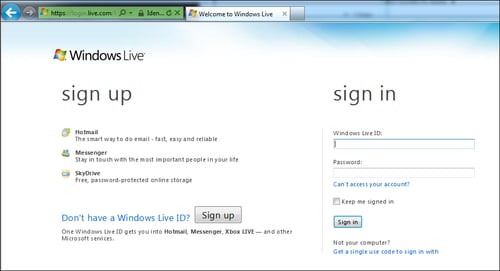
The integration with Windows Live ID is a big change compared to the on-premise version of TFS. Team Foundation Services doesn't currently support Active Directory integration.
Your account is now created and you're taken to the start page:
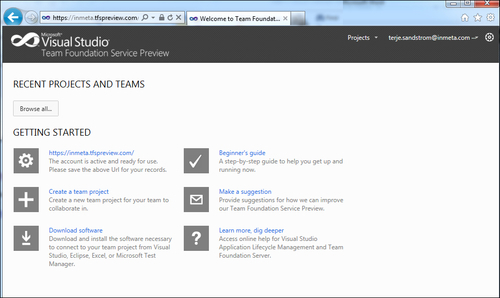
That's it; you now have access to TFS anywhere from a PC with an Internet connection! Note that this web access is the same as the one included included in the on-premise installs. In the Top Features section, you will learn how to get started using it.
TFS 2012 can be accessed in many ways. The different roles can use different tools, as described in the introduction. If you are a developer, you can use any of the Visual Studio editions from VS 2005 and upwards, given that you have the appropriate updates for the earlier versions.
If you are a developer, you need a compatible Visual Studio version; one of these would suffice:
Visual Studio 2012 (Professional or above), install from: http://www.microsoft.com/visualstudio/11/en-us/downloads
Visual Studio 2008 or 2010 (Professional or above) with their respective forward-compatibility patches from http://support.microsoft.com/kb/2673642 or http://support.microsoft.com/kb/2662296
The editions of Visual Studio 2012, which can access TFS 2012, are Professional, Premium, and Ultimate, or for testers the Microsoft Test Manager in the Test Professional SKU. Visual Studio Express can use TFS Express edition.
If you are developing code on non-Windows machines, for example using the Eclipse IDE, then you can use Team Explorer Everywhere (TEE) to access your TFS 2012 installation. Download TEE from http://www.microsoft.com/en-us/download/details.aspx?id=29933.
Users of Office Excel and Project 2007 and 2010 can access TFS 2012 by installing the Team Explorer, which also installs the required add-in components for Office.
When installing Visual Studio 2012, it will also install the required components for Office PowerPoint that can be used for storyboarding your applications.
Users who don't use any tools can still use the TFS 2012 Web Access with its new revamped Agile Workbench solution. For license details, see http://www.microsoft.com/en-us/download/details.aspx?id=13350.
This section goes through the major important features of the TFS 2012, which you need to create a complete development workflow for the team.
The Team Explorer is the main point of access when working with TFS 2012. It ships as a part of Visual Studio 2012, but you can also install it separately. You access Team Explorer from View | Team Explorer.
Team Explorer consists of several "pages", where each page gives access to the main features of TFS. We will list them shortly here; the rest of this chapter expands on the top features.
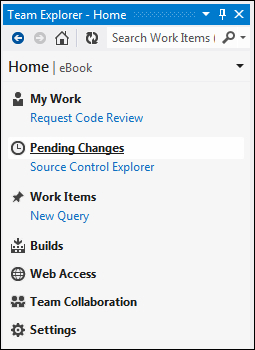
The Home page gives you links to the other pages, which are listed as follows:
My Work: The developers will spend most of their time here. It displays only the work that is relevant for the developer, and provides an easy way to associate their changes with the correct work item.
Also, this page lets developers suspend what they are currently doing to work on something else. When they are finished, they can resume the previous work, which includes modified source files, associated work items, windows that were open, and other IDE settings.
Last but not least, this page contains an integrated workflow for doing code reviews. This page is available in Premium and Ultimate editions. For more information on how to do code reviews in Visual Studio 2012, see http://msdn.microsoft.com/en-us/library/hh474795.aspx.
Note that the My Work page is only available in the Visual Studio Premium Edition and above.
Pending Changes: This page shows all the changes that are done locally and haven't yet been checked in. The changes can be associated to work items, and can also be shelved in order to start working on something else, for example.
Work Items: This page shows all work item queries in the current team project, and lets users create new queries that can be shared with the rest of the team.
Builds: This page gives access to all build definitions in the team project. You can also manage the build resources, for example the build controllers and build agents that will execute your builds.
Web Access: This is just a link to the web access portal for the current team project.
Team Collaboration: If you have installed the Team Foundation Server Power Tools, then Team Explorer will integrate with Microsoft Lync and MSN Messenger in order to promote communication within the team. This hub shows the status for each team member (if they are running Microsoft Lync or MSN Messenger) and lets you see TFS-related information about them, such as their check-in history.
Settings: This page shows links to all the administration tasks that can be done, both for the current team project and the team project collection. Most of these links will redirect the user to the web access to complete the task, but some are available inside the Team Explorer.
Version control is the heart of TFS 2012. You use version control to store your source code and any other artifacts that are a part of the development of your products. In this section, you will learn about the core features and concepts of TFS 2012 version control.
The Source Control Explorer window (available from the Home page in the Team Explorer) shows a full source control repository for the team project collection. Basically, it works in a manner similar to Windows Explorer and lets you browse, search, and perform actions on files and folders.
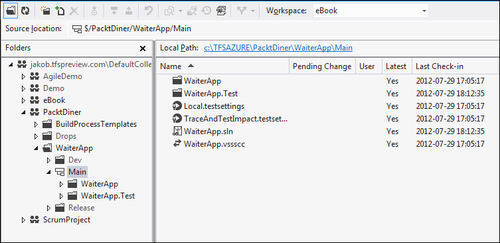
The workspace is a mapping between the TFS source control repository and your local development machine. You must create at least one workspace before you can download and modify anything in the source control. There are two types of workspace, namely Server workspaces and Local workspaces.
A local workspace is new to TFS 2012 and allows for local work in offline scenarios. You can check out, add, and remove files when offline. It synchronizes with the server when you're online again. The server workspace, on the contrary, keeps all the information about your workspace on the server.
Every time you check in one or more modified source files, TFS bundles these files together into a changeset. A changeset contains the modified source files, and the following information:
A Changeset ID that is unique across a Team Project Collection
A comment written by the person who performed the check-in
The date and time of the check-in
One or more associated work items
Check-in notes, which can be used for code reviews and auditing
Violations of check-in policies
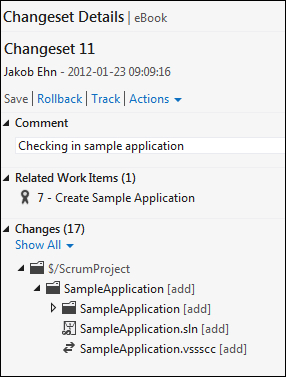
A changeset is atomic, meaning that it will either be fully committed to TFS or, in case of any error, not committed at all.
All the changes that are you are currently working on are automatically added to the set of pending changes. Every type of change is a pending change, including edits, moves, branches, and deletes. It is not until you check in your pending changes that these are committed to the TFS source control repository as a changeset.
The Pending Changes tab will show the files as included if they match the Team Explorer rules for files to include by default. Normally, these files are a part of the current solution. The remaining modified files in your workspace will be shown under excluded. You can move files between included and excluded by dragging them between their headings:
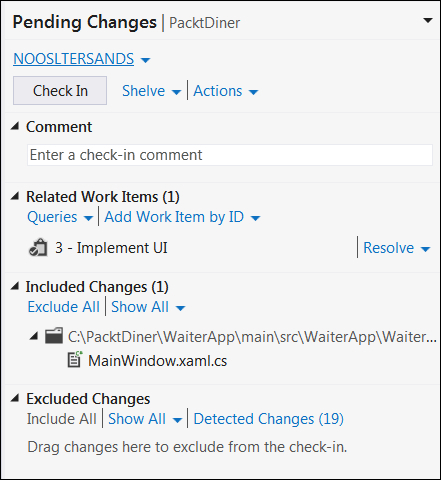
When you want to download the latest changes that have been checked in, you need to right-click and select Get Latest Version in the source control explorer.
Sometimes, you will need to get another specific version of a file or project. This is done by using the Get Specific Version command, located under the Advanced sub-menu in the source control.
TFS keeps a track of all changes made to the items in the source control and users who performed the change. Often, you will want to view the history of a file or a complete folder, which can be done right in the source control explorer:

You can view details of each changeset within the history list, and you can also compare the differences for a file or folder between any given versions:
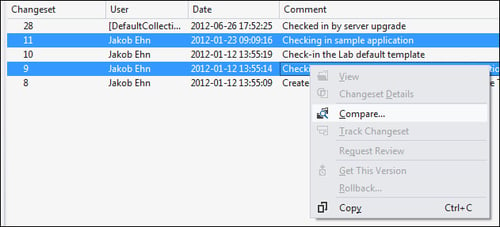
When looking at the source code, you will often find yourself wondering who wrote that code and why. You can answer this question by using the Annotate function. It will show which user had last modified any particular line of code, with a link to the corresponding changeset.

When clicking on the link in the left bar, you will get the full changeset details, including comments and work items that should answer why the change was made.
Sometimes, you may work on a new feature that is partly done and suddenly get interrupted by something else. At such times, you may not want to keep your changes lying around on your local machine, but commit them back into the main repository. These changes might not even compile. This is one occasion where shelvesets are very useful. A shelveset is basically a changeset that is not checked into the main repository. You can gain several benefits by shelving your changes, a few of which are listed as follows:
The changes are stored and backed up together with the rest of the repository
You can "unshelve" the changes onto another machine
Other team members can unshelve your changes onto their machine, for reviewing your code or helping you out with something
When setting up the source code structure for a new project, you should always prepare for branching. To support branching, you need to make sure that the project is contained within a top-level node that indicates which branch it belongs to. The following screenshot is an example:
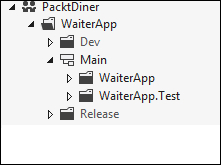
We have created a Main branch, where the source will be added in the beginning of the project. Later on, you can branch from the Main folder. Here we have created a Dev folder that will contain the development branches and a Release folder, which will contain the released branches. This will make sure that Main is the parent of all other branches, and any changes that are done must flow through the Main branch.
To create a new branch, select a folder in the source control explorer, right-click and select Branching and Merging | Branch.
In this example, we create a branch from the Main folder (source) and name the Target (child) branch Release\1.0.
A common scenario is that a bug may occur in production that needs to be fixed as soon as possible. We can fix the bug in the Release branch and build a new version of the product. Later, we need to merge the bug fix back to Main. Do this by selecting the Release/1.0 branch in source control, and select Branching and Merging | Merge.
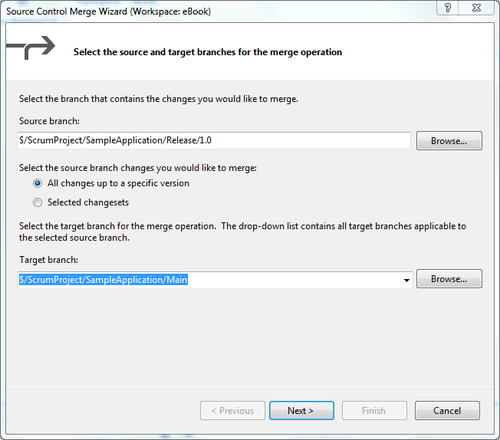
In the preceding dialog box, we can select the source and the target branches (we can only select the branches that are either a child or a parent of the source branch). We can also select to merge all the changes up to a specific version (often the latest version), or select specific changesets (often called a Cherry Pick Merge).
Branch hierarchies can grow complex over time, making it hard to visualize how they are connected to each other. To view the branch hierarchy, select Branching and Merging | View Hierarchy.

In the preceding screenshot, you can see a branch hierarchy where the Main branch has three child branches—one development branch (FeatureA) and two release branches (1.0 and 2.0).
Tip
Give branches meaningful names
When visualizing branches, only the branch name is visible so give them meaningful names. For example, ProjectName_1.0 instead of just 1.0, but keep in mind the total path length limits (260 chars on file, and 399 chars in source control after TFS 2012 Update 1).
A bug is initially fixed in one of the branches. Use the Track Changeset/Work Item feature in TFS to see where the work item or changerset was initially resolved and to which branches the change have been merged.
In the following example, we have a bug (ID 27) that was initially fixed in the Release 1.0 branch:

As indicated by the colors, the bug fix was merged to Main (Changeset 60) and then it was merged to the FeatureA development branch (Changeset 61). However, it has NOT been merged to the FeatureB or the Release 2.0 branch.There is also a Timeline Tracking view that shows the same information in time sequence, which can be very useful.
Tip
Merge changes by drag-and-drop between the branches
In both these views, we can merge the changes by dragging the boxes between the branches. The drag/drop operation will open the Merge dialog box.
The Visual Studio ALM Rangers have published a branching guidance, containing industry best practices; see http://vsarbranchingguide.codeplex.com/.
You must use work items when you need to track work in TFS. Work items exist in different types, for tracking a specific type of work that needs to be done.
The set of work item types you have available is determined by the process template you selected while creating the Team project. TFS comes with different process templates. These can be thought of as blueprints for new team projects, and may contain default information for work item types, default permissions, and build templates.
One of the most popular process templates is the Microsoft Visual Studio Scrum 2.0 process template , which contains the following main work item types:
Product Backlog Item: These work items are the work that a product owner wants to be implemented and that can be prioritized against other items on the backlog.
Task: PBIs are broken down into smaller Task work items. Each Task work item can then be assigned to a developer for implementation.
Bug: These work items represent a bug that has occurred either in production or during internal testing. Bugs are normally prioritized against other PBIs on the backlog
Impediment: An impediment in scrum is something that stops the team from finishing their sprint goal.
Here is an example of a work item of the PBI type:
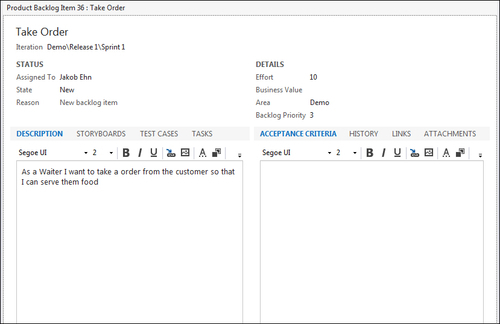
In this work item type, there are a total of eight different tabs that contain information. TFS 2012 Power Tools includes a tool that lets you customize process templates and work item types using a GUI. After the power tools have been installed, you can access the features from Tools | Process Editor.
Tip
When customizing work item types, start from one of the existing work item types and make your modifications to it.
Also, it's best practice to keep your work items under the source control. Create a separate team project to keep all your TFS-related artifacts.
For more information on Work Item Type customization, see http://msdn.microsoft.com/en-us/library/ms195025(v=vs.90).aspx.
There are several tools at your disposal when it comes to creating (and viewing) work items in TFS. When creating one or a few work items, you will normally use either Team Explorer or TFS Web Access.
The following screenshot shows how it looks in the Team Explorer. From the Work Items page, you can create new top-level work items from the menu:
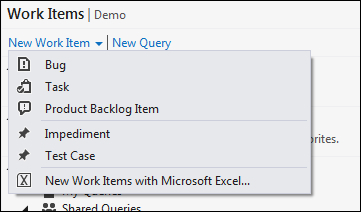
Subsequent child work items are created inside the parent work item form. Every work item can be linked to many other artifacts in TFS, such as other work items, source control changesets, and external URLs. This is a core feature that enables full traceability in your project between requirements, design, implementation, testing, and deployment.
You create links to other items of a variety of types by using the Links tab, and pressing either New or Link to.
The most common link type is Parent/Child. This is most commonly used to break down work into smaller tasks. Since this is so common, there is a separate tab called Tasks in the Product Backlog Item work item type. This lets you create subtasks for your PBI that are automatically linked as children.
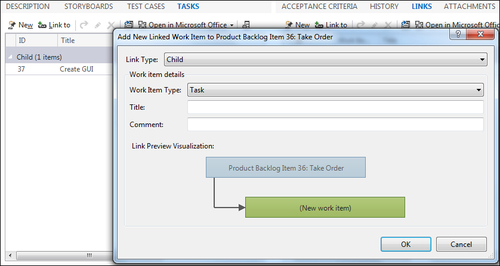
Another important tab is the Test Cases tab. This lets you create test cases (which are a work item type as well) for your requirements. You will learn more about this later in this section.
You can find work items in three ways:
Work item ID: Select Team | Go To Work Item and then enter the ID of the work item that you want to find
Searching the work items box in team explorer: This lets you search for any string value in all the work items in the current team project.
Refining your search by adding search filters: You can filter by Assigned To, Created By, State and Work Item Type. Each filter type can be expressed by a compact syntax, such as
C:"@Me", which will only return work items that were created by the current user.Work item queries: This is the most powerful way to access a list of work items. Since they can be saved and accessed by all team members, they are the main way to organize your project management.
A query can have several AND and OR clauses that filter the result; clauses can be grouped, and each query can be configured to return a specific set of columns and sort the order.
Tip
Prefer fewer queries
Avoid having too many queries, as they tend not to be used. Prefer a few good queries that are well used. Note that you can add your own queries to My own queries. This will avoid the team queries from getting clutter up.
Here is an example of a work item query that returns all the tasks in Sprint 1 that are blocked:
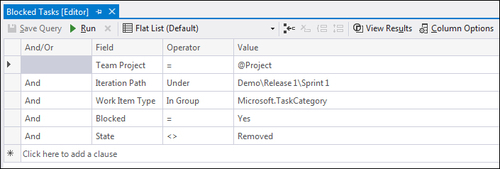
This query contains five different clauses, each of which filters in a different field. Clauses can be grouped by marking them and selecting Group.
Work item queries exist in three different flavors:
Flat list: This returns a list of work items that matches the filters. No linked work items are returned.
Work items and direct links: This returns the work items and any work items that are directly linked. Filters can be set for both the root and the link levels.
Tree of work items: This returns a hierarchical set of work items; meaning all matching work items and their children recursively.
Work item queries are organized per team project in a hierarchical fashion, using folders to separate groups of queries:
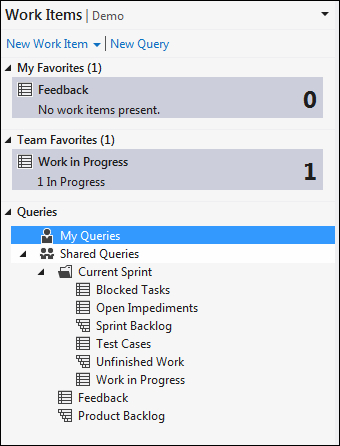
Current Sprint is a folder, which contains all the queries that apply to the current sprint. Note that this is only a convention, and there is no semantic relationship between the folder and the queries it contains. Also note that you can add work item queries to either My Favorites or Team Favorites, which also shows the total number of work items that those queries returned the last time they were executed.
Tip
Organize folders per team
If you use multiple applications per-team project, then you should mimic the same organization in the work item queries. Make one folder per application (or per "team", since team = application). Under each such folder, arrange the rest of the hierarchy in the same fashion.
Updating a few work items using either Team Explorer or the Web Access works fine, but often you will need to update many work items at the same time. In this scenario, you can use Microsoft Excel to batch update work items at the same time.
When using work item queries, you can right-click on them and select Open in Microsoft Excel, which will show the results of the query inside it. This works for all types of Work Item Queries; for example, flat lists, with direct links, and tree of work items.
Here is how the PBI query looks in Microsoft Excel:

When you install TFS 2012 Team Explorer (or Visual Studio 2012) on a computer that has Microsoft Excel installed, the Team ribbon is created. This is what makes the Excel TFS aware and lets you work efficiently with work items.
Since Excel cannot show a hierarchical date, it flattens the result by adding extra columns for each level.
To create a new child task for the Take Order PBI, select the row containing the Take Order work item and then press the Add Child button in the Team ribbon:

When the work item is saved, it will be given an ID (shown in the ID column). Press the Publish button to save.
The My Work hub contains all the artifacts that you are involved with during your work, across types. Work items can be activated (move to In Progress) directly in the hub, and you will also see all the code review feedback you're involved in.
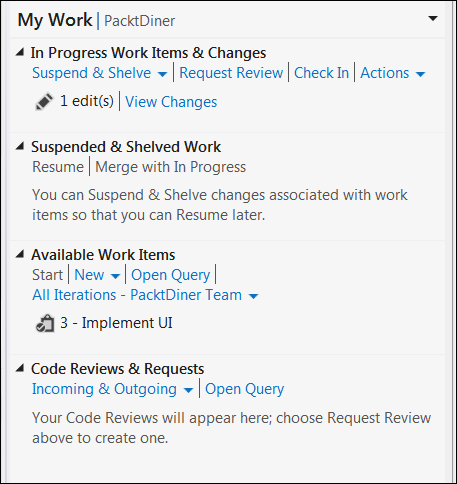
The Implement UI task is available here. You can drag it directly to In Progress Work Items & Changes, to tell that you're now working on this item:
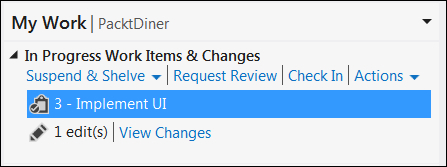
When you do this, it will automatically change the state to Active and become associated with the current pending changes.
In TFS 2012, the TFS Web Access was rewritten in order to fully embrace the concept of Agile planning. This includes concepts such as Product Backlogs, Sprint Backlogs, Tasks, and Kanban boards, and is a common practice among teams who practice Agile methodologies.
In the Quick Start section, we covered iteration planning and setting up a product backlog. We will now expand on this with the remaining features.
A product backlog is central in Agile planning; this should contain everything that needs to be done for the corresponding product. Items in the product backlog are prioritized by their order on the backlog in a top to down manner.
To prioritize, you drag-and-drop the items:

To assign items to sprints, you select the item on the backlog and drag it to the sprint on the left of the screen. You will see the Iteration Path field update automatically when you do this.
To view the sprint backlog, click on the sprint link on the left side of the screen. This will show all the backlog items that are assigned to the selected sprints and their tasks:
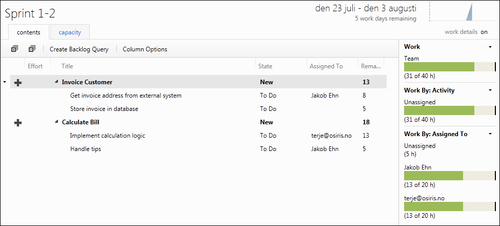
You can add new subtasks to the backlog items by clicking on the large plus icon (+) to the very left.
To the right, you can see the current capacity information for the current sprint. It shows how much of the total work is assigned to the team in this sprint (40 hours in this case) and how much of that work is allocated to each person and to the team in total (31 hours). In this case, the sprint looks OK; we haven't over allocated the team. If we add too much work, the fields will be marked with red color.
To be able to show this information, you need to define the capacity of each team member. This is done for each sprint and is done by clicking on the capacity tab:
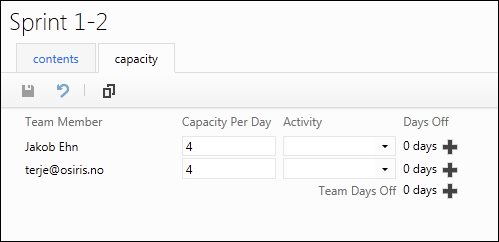
You set the capacity to how many hours per day each member can contribute (also restricting it to a certain activity), and to how many days during the sprint they will not be able to commit.
Development starts when the sprint is fully planned. During the course of the sprint, you normally have a daily stand-up meeting, where each team member briefly describes what they have been doing, what they will do today, and if they have any impediments. It is also a good moment to go through the remaining work for each task that is assigned to them. When doing this, you use the board task in the TFS Web Access:
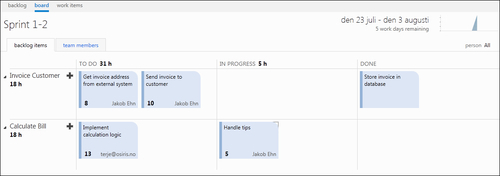
The board task shows all the backlog items to the left, with the total numbers of hours of remaining work below. All the implementation tasks are shown to the right in the corresponding state column.
In the upper-right corner, a small burn-down graph is shown; you can expand it by clicking on it. This is always up-to-date. Every time you change the remaining work or add a new task, the burn-down graph will reflect it immediately.
To change the state of a task, just drag it from the left to the right. Under the hood, TFS will update the necessary fields. You can easily assign a work item to another team member by clicking on the name in the task. You can also change the remaining work by clicking on the number in the lower-left of the task:
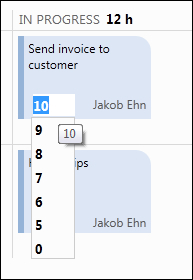
When you drag a task from IN PROGRESS to CLOSED, Remaining Work will automatically be cleared.
Tip
Prefer to create small tasks
Keep your tasks small. If they get too large, it will be too difficult to estimate the remaining, or even knowing if you're on track or not. Break it down into smaller tasks. A good range is 4 to 40 hours per task, with the majority of around 8 hours.
To see which tasks that are allocated to a specific team member, filter the board by clicking on the All link in the upper-right corner and then select that member. You can also group the entire board by team members.
Tip
Always keep Remaining Work updated
The Remaining Work field is central to make the burn-down graph and planning work. As a scrum master for your team, coach everyone to keep this updated. Never think about the past, always update with the value you feel is right TODAY.
There is a corresponding Kanban board, which is also very useful to get an overview of the state of the product backlog items.
Next to source control, the most important part in getting a continuous integration process working is build automation.
TFS 2012 Build is an end-to-end build automation engine for orchestrating the build process.
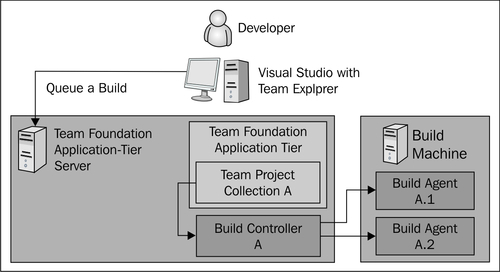
The two components of TFS Build are the Build Controller and the Build Agent. These are services running on one or multiple servers. Each build controller is registered with a single team project collection, and receives the request when a build is triggered. The build controller then queues the build on a suitable build agent.
Tip
Place the build controller on the TFS server
The build controller distributes a build to any available build agent on any build machine. By placing your build controller on the TFS server, and NOT on one of the build machines, you can avoid making any build machine a critical point of failure.
To create a build definition in TFS 2012, follow these steps:
In Team Explorer, click on the New Build Definition link on the Builds hub.
General: Enter a name for the build definition in a manner similar to the following:
<Product>.<Branch>.<Trigger>. For example,MyApplication.Dev.CI.Trigger: The trigger determines how the build should start.
Manual: The build must be triggered manually by a team member.
Continuous Integration (CI): The build will start automatically when a check-in occurs inside the workspace of the build.
Rolling Builds: Accumulate check-ins until the prior build finishes. You also have the option to define a fixed interval. If you set it to 15 minutes, the build will start at most every 15 minutes.
Gated check-in: A gated check-in is similar to a CI build, but with the difference that the check-in will only be accepted if the builds runs successfully. Larger and/or distributed teams can sometimes end up in a situation where the builds keep failing and no-one manages to get it back to the working stage again. A gated check-in build makes sure that no one can check in something that breaks the build.
Tip
Use gated check-in in non-ideal situations
In a non-ideal world, teams do not always communicate as well as you would like them to. Especially when the teams are distributed globally, this can be a challenge. A broken build will then cause more pain than you can accept, and the pain killer is the gated check-in. However, if you can improve team communication, prefer that over a gated check-in.
For more information on gated check-in builds, see http://msdn.microsoft.com/en-us/library/dd787631(v=vs.110).aspx.
Schedule: Used for daily/nightly builds that should run once every day.
Workspace: Here, you define the workspace for the build. It is very important to make the workspace as small as possible, otherwise the build will download a lot of unnecessary source code every time the build runs.
Build Default: This specifies which build controller should handle the build.
You also define the
Dropfolder path here. This must be a server share where the build service account has read/write permissions. The recommended drop path is\\<Server>\<Share>\<TeamProject>\<Project>\<Trigger>, for example:\\server\drop\eBook\SampleApplication\CI.Process: Configure what the build should do. First of all, you must select which build process template should be used. By default, you have three different templates to choose from:
DefaultTemplate11.X.xaml: This is the standard template that you should use for most build definitions. It also serves as the basis for customizations. It implements a full end-to-end build with label, compile, analyze, test, copy to drop, report, and notification.
UpgradeTemplate.xaml: This is used for build definitions that were upgraded from earlier versions of TFS 2005 and 2008. It is a minimal workflow template that launches MSBuild to execute a MSBuild project file. Use this as a temporary solution until you have converted your older builds to TFS 2012.
LabDefaultTemplate.11.xaml: This is used for builds that implement a full Build-Deploy-Test (BDT) workflow. This is related to lab management, where you want to deploy the build to one or more virtual or physical machines and then perform tests on those machines as a part of the build.
For more information on this topic, see http://msdn.microsoft.com/en-us/library/ee471614(v=vs.110).aspx.
Select DefaultTemplate.11.X.xaml. Now, you need to define the build process parameters for this build definition:

The only required parameter is Items to Build. This is the path to one or more projects/solutions in source control that should be built. You can also configure the configuration(s), such as Debug | Any CPU, for example.
The rest of the parameters have default values, which do not require any extra input, but you will want to learn what these are and what they do. You can, for example, configure log verbosity, the format of the build number, which build agent should be selected for the build, and so on.
Retention Policy: On the last tab, you can configure how many builds of each outcome should be stored. This is to avoid the drop folders and the TFS database to grow too much. For each outcome, you can configure what should be deleted.
You are done; save the build definition.
To run a build manually, right-click on the build definition in Team Explorer and select Queue New Build.
This brings up the Queue Build dialog box, where you can override several build settings and parameters for this build before starting it. The CI, Rolling, or Gated Check-in builds will start automatically when you check in. The queued build shows up under the My Builds section in the Builds hub. Double-click on it to see the build summary:
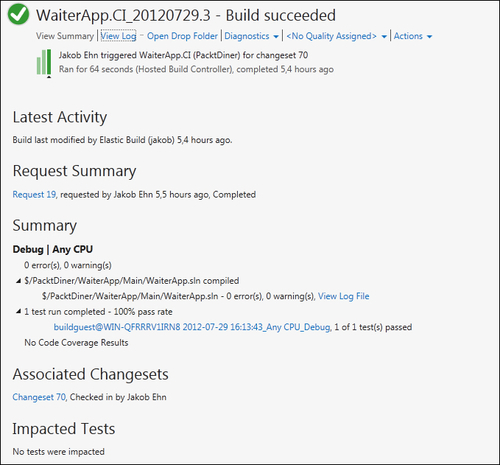
The build summary shows all the relevant information of the build, with links to the complete log and drop folders where you can access the output from the build.
You will eventually need to modify the build workflow, for example, if you want to copy the build output to a specific location. For guidance and best practices on build customization, see the Visual Studio ALM Rangers guidance for how to do that at http://vsarbuildguide.codeplex.com/.
If you need help with Team Foundation Server 2012, here are some people and places which will prove invaluable:
Visual Studio Homepage: http://www.microsoft.com/visualstudio/en-us
Team Foundation Server on Channel 9, useful videos: http://channel9.msdn.com/Tags/team+foundation+server
Visual Studio ALM and Team Foundation Server Blog: http://blogs.msdn.com/b/visualstudioalm/
All the extensions you need, find them on the Visual Studio Gallery: http://visualstudiogallery.msdn.microsoft.com/
ALM Overview: http://www.microsoft.com/visualstudio/eng/alm/overview
Customizing Team Build, blog series by Ewald Hofman: http://www.ewaldhofman.nl/post/2010/04/20/Customize-Team-Build-2010-e28093-Part-1-Introduction.aspx
Guidance on using friendly DNS names in your TFS environment: http://www.edsquared.com/2011/01/03/Using+Friendly+DNS+Names+In+Your+TFS+Environment.aspx
Visual Studio ALM Rangers: http://msdn.microsoft.com/en-us/vstudio/ee358787.aspx
Visual Studio Team Foundation Server Forums: http://social.msdn.microsoft.com/Forums/en-US/category/vstfs
StackOverflow TFS: http://stackoverflow.com/questions/tagged/tfs
Radio TFS: A great podcast around Visual Studio and TFS: http://www.radiotfs.com/
Community TFS Build Extensions: http://tfsbuildextensions.codeplex.com/
Brian Harry, Product Unit Manager for TFS: http://blogs.msdn.com/b/bharry/
Brian Keller, Microsoft Sr. Technical Evangelist for Visual Studio ALM: http: //blogs.msdn.com/b/briankel/
Ed Blankenship, Program Manager Visual Studio Testing & Lab Management: http://www.edsquared.com/
Martin Hinshelwood, Senior ALM Consultant and ALM MVP: This blog contains tons of useful guidance around Visual Studio and TFS – http://blog.hinshelwood.com/
Neno Loje, a leading German author and ALM MVP: http://msmvps.com/blogs/vstsblog/
Marcel de Vries, Dutch speaker and ALM MVP: http://blogs.infosupport.com/author/marcelv/
Adam Cogan, ALM MVP, speaker and Regional MS Technical Director for Austrialia: http://www.adamcogan.com/
Jeff Levinson, ALM MVP and author: http://blog.nwcadence.com/author/jefflevinson/
Tarun Arora, ALM MVP, active blogger and ALM MVP: http://geekswithblogs.net/tarunarora/Default.aspx
Martin Woodward, Program Manager Visual Studio Team Explorer Everywhere: http://www.woodwardweb.com/
Ricci Gian Maria, ALM MVP, active blogger: http://www.codewrecks.com/blog/
Urban Turtle Agile/Scrum Management Tools for TFS: http://urbanturtle.com/
TeamPulse Agile Project Management Tools: http://www.telerik.com/agile-project-management-tools/
InRelease – Agile Release Management for TFS: http://www.inreleasesoftware.com/
inteGREAT Requirement Management Tools for TFS: http://www.edevtech.com/products.html
See the following books for diving deeper into the TFS:
Professional Application Lifecycle Management: http://www.amazon.com/gp/product/1118314085
Professional Team Foundation Server: http://www.amazon.com/gp/product/1118314093
Software Testing with Visual Studio 2010: http://www.amazon.com/dp/0321734483
Agile Software Engineering with Visual Studio: http://www.amazon.com/Agile-Software-Engineering-Visual-Studio/dp/0321685857
Pro Application Lifecycle Management with Visual Studio 2012: http://www.amazon.com/Application-Lifecycle-Management-Visual-Professional/dp/1430243449
A list of useful extensions can be found at http://geekswithblogs.net/terje/archive/2012/03/22/visual-studio-amp-tfs-11-ndash-list-of-extensions-and.aspx
The Visual Studio Team Foundation Server Power Tools is very useful for all who use TFS 2012: http://visualstudiogallery.msdn.microsoft.com/27832337-62ae-4b54-9b00-98bb4fb7041a
Follow Microsoft's Jason Zander on Twitter: http://twitter.com/#!/jlzander
Follow ALM MVP and ALM Ranger Build Guide Lead Mike Fourie at http://twitter.com/#!/MikeFourie
Follow Willy-Peter Schaub, Microsoft ALM Ranger at http://twitter.com/#!/wpschaub
For more open source information, follow Packt at http://twitter.com/#!/packtopensource



















